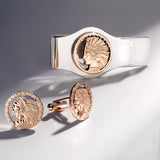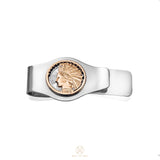The Native American head was exposed on the coin with a few cutouts. Careful polishing further refines all the details.
Since the 1790s, the so-called gold Eagle coins with denominations of $2.5, $5, and $10 were legal tender in the United States. The $10 Indian Head coin was minted in 1906 as the successor to the coin featuring Lady Liberty. It marks the end of the approximately 150-year coin era.
The major stock market crash in the United States in 1929 prompted the American government to fundamentally halt the issuance of gold coins. Due to the continued rise in the price of gold in the years following the Great Depression, all tangible coins were melted down.
When examining all three coins, it's noticeable that the portrait on the $10 coin differs from the other two. This is because the Native American's face is modeled after that of Lady Liberty, who was originally imprinted on the coin, and thus appears significantly more delicate and feminine.
money clip
What's special about this money clip is that it's not a replica of the coins, but a genuine American gold coin. As can be seen from the engraved date, some of these coins are already around 100 years old. The coins already have a very high intrinsic value, which is further enhanced by their treatment.









